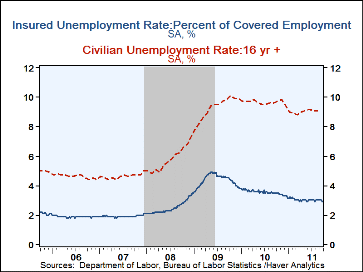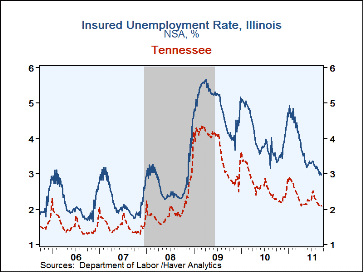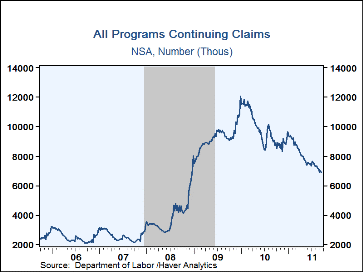 Global| Oct 06 2011
Global| Oct 06 2011U.S. Weekly Initial Claims for Jobless Insurance Tick Higher But Trend Sideways
by:Tom Moeller
|in:Economy in Brief
Summary
They've done this before. Initial claims for jobless insurance rose a slight 6,000 to 391,000 last week from 395,000 (revised from 391,000). Together, the two numbers were near the lowest of 2011. However, this reaching for a low was [...]
They've done this before. Initial claims for jobless insurance rose a slight 6,000 to 391,000 last week from 395,000 (revised from 391,000). Together, the two numbers were near the lowest of 2011. However, this reaching for a low was done earlier. Twice before this year, claims declined then backed up to leave in place a trend level near 415,000 since February. The latest figure was below Consensus expectations for 410,000 claims, according to the Action Economics survey. The 4-week moving average of claims slipped to 414,000. During the last ten years there has been a 76% correlation between the level of claims and the m/m change in payroll employment.
Continuing claims for unemployment insurance fell to 3.700M in the September 24th week. It also has been trending sideways since early this year. The insured unemployment rate slipped to 2.9%. By state, the rate varied with Virginia (1.4%), Oklahoma (1.7%), Texas (1.8%), Ohio (1.8%), Colorado (2.0%) and Tennessee (2.1%) at the low end of the range. The rates in Illinois (3.0%), Connecticut (3.2%), Nevada (3.3%), New Jersey (3.4%, California (3.5%) and Pennsylvania (3.9%) were at the high end.
The grand total of those receiving unemployment insurance, including extended programs run by the states and the federal government, was 6.862M as of September 17, down by one-quarter y/y. Regular extended benefits, with eligibility dependent on conditions in individual states, recovered the prior week's decline with a rise to 524,685 (-48.1% y/y) and those on the special "EUC 2008" programs slipped to 3.027M (-26.6% y/y).
Data on weekly unemployment insurance programs are contained in Haver's WEEKLY database, including the seasonal factor series, and they are summarized monthly in USECON. Data for individual states, including the unemployment rates that determine individual state eligibility for the extended benefits programs and specific "tiers" of the emergency program, are in REGIONW, a database of weekly data for states and various regional divisions. Action Economics estimates are in AS1REPNA.
Unemployment Insurance and the Great Recession from the University of California, Berkeley and NBER can be found here.
| Unemployment Insurance (000s) | 9/31/11 | 9/24/11 | 9/17/11 | Y/Y% | 2010 | 2009 | 2008 |
|---|---|---|---|---|---|---|---|
| Initial Claims | 401 | 395 | 428 | -10.7 | 461 | 577 | 413 |
| Continuing Claims | -- | 3,700 | 3,752 | -16.9 | 4,544 | 5,807 | 3,338 |
| Insured Unemployment Rate(%) | -- | 2.9 | 3.0 | 3.5 (9/10) |
3.6 | 4.4 | 2.5 |
| Total "All Programs" (NSA) | -- | -- | 6.862M | -24.3 | 9.850M | 9.163M | 3.903M |
Mixed Employment Indicators For September Tomorrow's jobs report will indicate whether the recent weakness in payrolls continued. The indicators now in hand from several advance data-series give mixed signals for September. However, overall, they lean toward a weak reading in payrolls. The current Consensus forecast, according to Action Economics, is for a rise in payrolls of 56,000. That would be one of the weakest this year and continues the deterioration versus 2010.
Pointing toward moderate deterioration versus August is the rise in initial claims for jobless insurance, a decline in the employment component of the ISM non-manufacturing series and the rise in Challenger job cut announcements. Countering these is the rise in the ISM manufacturing employment component and a weak, but stable, ADP number.
| Employment Indicators | September | August | July |
|---|---|---|---|
| Nonfarm Payrolls (M/M Change, 000s) | -- | 0 | 85,000 |
| Initial Unemployment Insurance Claims (Survey Week) | 428,000 | 412,000 | 422,000 |
| Purchasing Managers Mfg. Employment Index | 53.8 | 51.8 | 53.5 |
| Purchasing Managers Non-Mfg. Employment Index | 48.7 | 51.6 | 52.5 |
| ADP Private Employment Change | 91,000 | 89,000 | 107,000 |
| Challenger Job Cut Announcements | 115,730 | 51,114 | 66,414 |
Tom Moeller
AuthorMore in Author Profile »Prior to joining Haver Analytics in 2000, Mr. Moeller worked as the Economist at Chancellor Capital Management from 1985 to 1999. There, he developed comprehensive economic forecasts and interpreted economic data for equity and fixed income portfolio managers. Also at Chancellor, Mr. Moeller worked as an equity analyst and was responsible for researching and rating companies in the economically sensitive automobile and housing industries for investment in Chancellor’s equity portfolio. Prior to joining Chancellor, Mr. Moeller was an Economist at Citibank from 1979 to 1984. He also analyzed pricing behavior in the metals industry for the Council on Wage and Price Stability in Washington, D.C. In 1999, Mr. Moeller received the award for most accurate forecast from the Forecasters' Club of New York. From 1990 to 1992 he was President of the New York Association for Business Economists. Mr. Moeller earned an M.B.A. in Finance from Fordham University, where he graduated in 1987. He holds a Bachelor of Arts in Economics from George Washington University.










